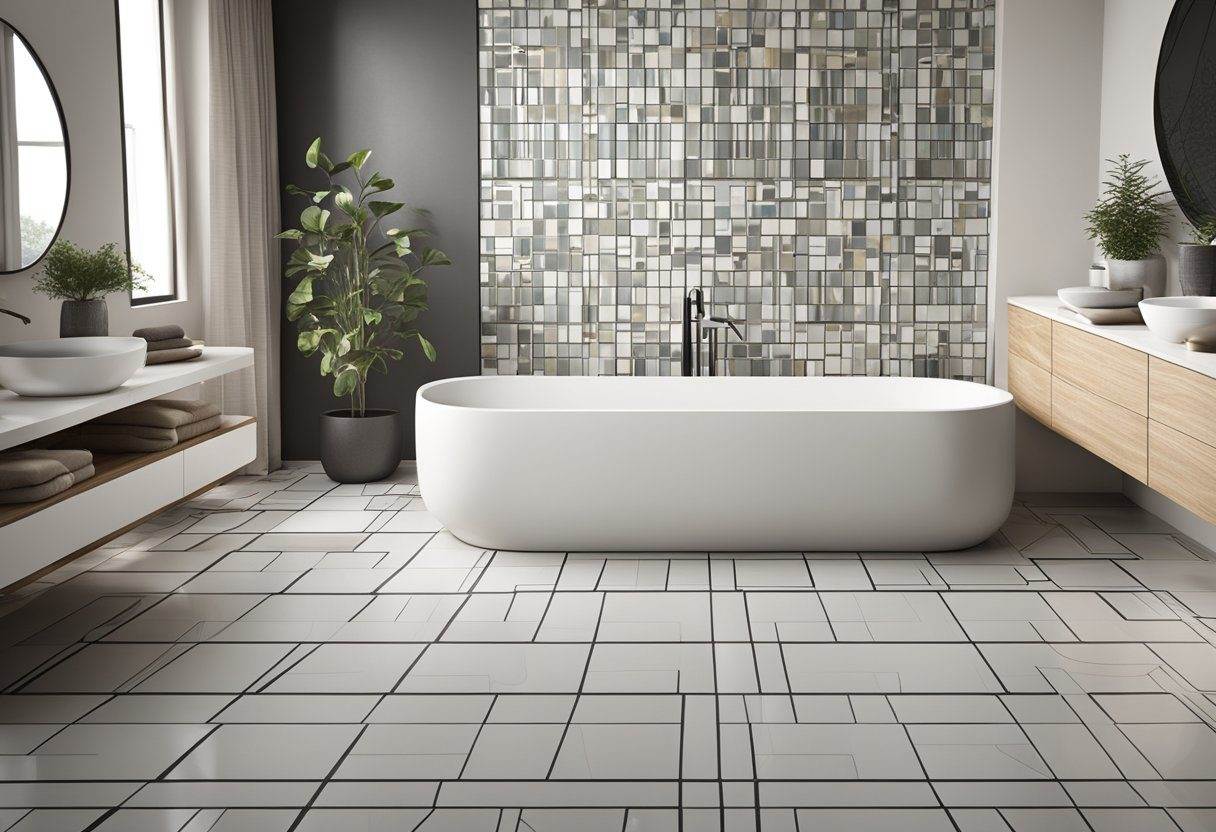Bathroom tiles are an essential component of any bathroom renovation. They not only add aesthetic appeal but also provide a practical solution to keeping the bathroom clean and hygienic. With a wide range of options available, choosing the right bathroom tiles can be a daunting task. In this article, we will guide you through the process of selecting the perfect bathroom tiles for your space.
Understanding bathroom tiles is the first step in designing your dream bathroom. From ceramic to porcelain, natural stone to glass, each type of tile has its own unique characteristics that make it suitable for different areas of the bathroom. Designing with bathroom tiles is also an important consideration, as the right combination of colours, textures, and patterns can transform a simple bathroom into a luxurious spa-like retreat. Tile durability and maintenance are also important factors to consider, as bathroom tiles are exposed to high levels of moisture and foot traffic.
Key Takeaways
- Understanding the different types of bathroom tiles is essential before making a purchase.
- Designing with bathroom tiles can add aesthetic appeal and transform your bathroom into a luxurious retreat.
- Tile durability and maintenance are important considerations for keeping your bathroom tiles looking their best.
Understanding Bathroom Tiles
When it comes to renovating your bathroom, choosing the right tiles is crucial to achieving the look and functionality you desire. In this section, we will discuss the different types of bathroom tiles available and the pros and cons of each.
Types of Bathroom Tiles
- Ceramic Tiles: Ceramic tiles are a popular choice for bathroom floors and walls. They are available in a wide variety of colours, patterns, and finishes. Ceramic tiles are easy to clean and maintain, and they are also durable and water-resistant.
- Porcelain Tiles: Porcelain tiles are similar to ceramic tiles but are denser and more durable. They are also highly water-resistant and can be used for both floors and walls. Porcelain tiles are available in a range of colours, patterns, and finishes, including matte, polished, and textured.
- Natural Stone Tiles: Natural stone tiles, such as marble, granite, and slate, are a luxurious and elegant option for bathroom floors and walls. They are durable and long-lasting, but they do require regular maintenance to keep them looking their best.
- Mosaic Tiles: Mosaic tiles are small tiles that are arranged in a pattern to create a design. They are available in a range of materials, including ceramic, porcelain, and glass. Mosaic tiles are a great option for creating a feature wall or adding a pop of colour to your bathroom.
Pros and Cons of Various Tiles
- Ceramic Tiles: Pros – Affordable, easy to clean and maintain, durable, water-resistant. Cons – Can crack or chip if heavy objects are dropped on them.
- Porcelain Tiles: Pros – Durable, water-resistant, low-maintenance, available in a range of colours and finishes. Cons – Can be more expensive than ceramic tiles.
- Natural Stone Tiles: Pros – Luxurious and elegant, durable, long-lasting. Cons – Require regular maintenance, can be expensive.
- Mosaic Tiles: Pros – Available in a range of materials, colours, and patterns, great for creating a feature wall or adding a pop of colour. Cons – Can be more expensive than other types of tiles, may require more maintenance.
In conclusion, choosing the right bathroom tiles is an important decision that can greatly impact the overall look and functionality of your bathroom. Consider the pros and cons of each type of tile and choose the one that best suits your needs and budget.
Designing With Bathroom Tiles
When it comes to designing with bathroom tiles, your choices of colour and pattern can significantly impact the overall aesthetic of the space. Consider using light and neutral colours to create a sense of spaciousness, while bold and vibrant patterns can add personality and visual interest to the room.
Colour and Pattern Choices
For a timeless and elegant look, classic white or light grey tiles can create a clean and fresh atmosphere in the bathroom. If you prefer a more striking design, consider incorporating mosaic or geometric patterned tiles to add a modern touch to the space. Additionally, using tiles with subtle textures can enhance the visual appeal of the bathroom while providing a tactile experience.
Tile Size and Placement
Selecting the right tile size and placement is crucial for achieving a balanced and harmonious design. Large format tiles can make a small bathroom appear more expansive, while smaller tiles can be used to create intricate patterns and details. Moreover, the way tiles are positioned, whether vertically, horizontally, or in a herringbone pattern, can significantly impact the visual flow and perception of space in the bathroom.
Tile Durability and Maintenance
Cleaning and Care
Regular cleaning and care are essential for keeping your bathroom tiles looking great. Here are some tips for cleaning and caring for your tiles:
- Sweep or vacuum regularly: Dirt and dust can accumulate on your tiles, making them look dull and dirty. Sweep or vacuum your tiles regularly to keep them clean.
- Mop with a mild detergent: Use a mild detergent and warm water to mop your tiles. Avoid using harsh chemicals or abrasive cleaners, as these can damage your tiles.
- Wipe up spills immediately: Spills can stain your tiles, so it’s important to wipe them up immediately. Use a damp cloth to wipe up spills, and dry the area thoroughly.
- Avoid using high-pressure cleaners: High-pressure cleaners can damage your tiles, so avoid using them in your bathroom.
Repair and Replacement
Even with proper care and maintenance, your bathroom tiles may need to be repaired or replaced at some point. Here are some tips on how to repair or replace your tiles:
- Replace individual tiles: If a single tile is damaged, you can replace it without having to replace the entire floor. Use a chisel and hammer to remove the damaged tile, and then replace it with a new one.
- Repair cracks and chips: If your tiles have cracks or chips, you can repair them with epoxy or grout. Clean the area thoroughly, and then apply the epoxy or grout with a putty knife.
- Consider professional help: If you’re not comfortable repairing or replacing your tiles yourself, consider hiring a professional. They can ensure that the job is done correctly and safely.
By following these tips, you can ensure that your bathroom tiles are durable and well-maintained. Regular cleaning and care, as well as prompt repairs and replacements, can help keep your bathroom looking great for years to come.
Safety Considerations
When it comes to bathroom tiles, safety should be a top priority. Here are some safety considerations to keep in mind:
Slip Resistance
Bathroom tiles can become slippery when wet, which can lead to falls and injuries. To prevent this, it’s important to choose tiles with slip-resistant properties. Look for tiles with a high slip resistance rating, such as R10 or R11. These ratings indicate that the tiles have been tested and certified to provide good slip resistance, even when wet.
In addition to choosing slip-resistant tiles, you can also take other measures to prevent slips and falls in your bathroom. For example, adding a non-slip bath mat or rug can provide extra traction and reduce the risk of slipping. You can also install grab bars near the shower or bathtub to provide support and stability.
Hygiene Factors
Bathrooms can be breeding grounds for bacteria and germs, which can be harmful to your health. To maintain good hygiene in your bathroom, it’s important to choose tiles that are easy to clean and disinfect. Porcelain and ceramic tiles are good options, as they are non-porous and resistant to moisture, which makes them less likely to harbor bacteria.
When cleaning your bathroom tiles, it’s important to use the right products and techniques. Avoid using harsh chemicals or abrasive cleaners, as these can damage the tiles and make them more difficult to clean in the future. Instead, use a mild detergent and warm water, or a cleaning solution specifically designed for tiles.
By keeping these safety considerations in mind, you can create a beautiful and functional bathroom that is also safe and hygienic.
Renovation Tips and Tricks
Renovating your bathroom can be a daunting task, but with the right tips and tricks, it can be an exciting process. Here are some tips to help you with your bathroom renovation:
Plan Your Budget
Before you start your bathroom renovation, it is important to plan your budget. Determine how much you are willing to spend and stick to it. This will help you avoid overspending and ensure that you get the best value for your money.
Choose the Right Tiles
Choosing the right tiles is crucial to the success of your bathroom renovation. Consider the size of the tiles, the colour, and the texture. Large tiles can make a small bathroom look bigger, while smaller tiles can create a more intricate pattern. Additionally, tiles with a matte finish can provide better traction, reducing the risk of slipping.
Mix and Match
Mixing and matching tiles can create a unique and stylish look in your bathroom. Consider combining different colours, patterns, and textures to create a cohesive look. You can also use different tiles for the floor and walls to create contrast.
Consider Lighting
Lighting is an important aspect of any bathroom renovation. Consider adding task lighting around the vanity and shower, as well as ambient lighting to create a relaxing atmosphere.
Hire a Professional
While DIY bathroom renovations can be tempting, it is important to consider hiring a professional. A professional can provide expert advice, ensure that the renovation is done correctly, and save you time and money in the long run.
By following these tips and tricks, you can ensure that your bathroom renovation is a success.
Have a enquiry about Tiles?
Fill out the form below and one of our tile expert will get back to you.


